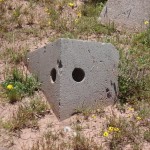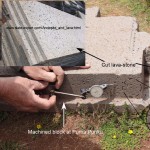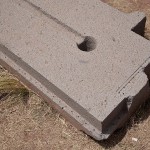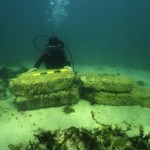Puma Punku
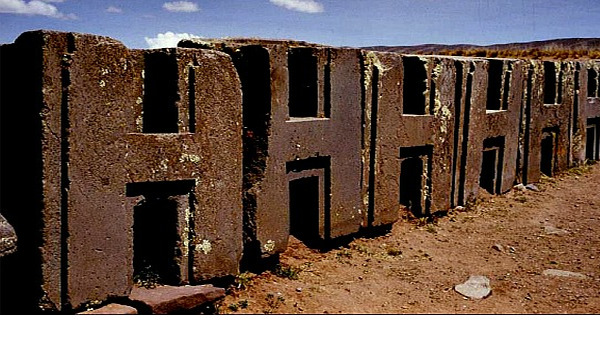
The mysterious ruins of Puma Punku are located in Bolivia, South America, in the Andes Mountains, 45 miles west of the country’s capital La Paz, at an altitude over 12,000 feet. Archeologists have no definitive answer as to what Puma Punku was, what it looked like, how it was built, by whom and to what end. Mainstream scientists believe Puma Punku was built some 2000 years ago. However, in 1945 another theory proposed by archeologist Arthur Posnansky emerged, according to which Puma Punku was way older. Posnansky was an arecheologist and researcher who spent many decades on the site. He studied the archeostronomy of the ruins and their alignment with the stars and deduced Puma Punku was built as far back as 15,000 BC.
| It is not possible to date the stones of Puma Punku. The available dating method is a radiometric dating technique that uses the decay of carbon-14 (14C) to estimate the age of organic materials, such as wood and leather. Stones cannot be dated with the method as there is no carbon decay in stone. Hence, science was only able to find circumstantial evidence for dating Puma Punku. However, how old the stones themselves are remains a mystery. | View Larger Map |
What baffles researchers of Puma Punku the most is how the place was built, given the size and mass of the megaliths (up to 26 feet and hundreds of tons). Mainstream science proposes the blocks were shaped by hand, with primitive tools that were available to the people living in the area in that era. Yet, engineers and architects who have had a chance to take a closer look at the ruins are positive that the builders of Puma Punku to achieve the results must have excelled in planning, logistics as well as have applied some sophisticated technology.
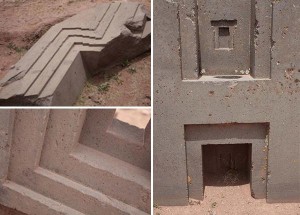
Even a brief examination of the stone work seems to suggest that some sort of precision, power tools must have been used to achieve the results. The stones are cut to a millimeter precision, with very accurate right angles. Sharp precision-corners and smooth drill-holes are carved in granite, which is one of the hardest materials on Earth. You need a diamond to be able to cut granite with that level of precision.
Nowadays, stone masons use diamond wet saws to cut large granite surfaces, and waterjet saws to cut intricate, precision shapes. Both the tools need electrical power to run. Below you can see what cutting hard granite and marble with a diamond wet saw looks like:
For more sophisticated shapes even more advanced tool is used. This clip demonstrates a waterjet saw in action cutting granite:
Compare this with these intricate drill-holes and precision-corners of the Puma Punku stones:
1. Machined drill holes?
2. Andesite block from Puma Punku vs. machined lava stone
3. Puma Punku precision masonry
Another interesting (and unanswered) question about Puma Punku is how the builders managed to transport the huge blocks of stone to the site and move them around the location. Mainstream science maintains that the blocks were quarried at a location 600 miles away and then rolled to Puma Punku on wooden logs. However, the altitude at which the ruins are located excludes that possibility as no trees grow naturally this high. As mentioned before the biggest block of Puma Punku weighs in excess of one hundred tons. In order to understand the scale of such operation it is worthwhile to take a look how such challenge is tackled today.
1 crane, 30 tons:
2 cranes, 50 tons. Please note the voiceover commentary. There are two tanks to be lifted/transported. The smaller one is 50 tons and needs two cranes to lift. The other one is 200 tons and there is no way the cranes can handle the job. The tank will need to be dismantled first.
3. And here is what it takes to lift weights in excess of 100 tons. This particular clip demonstrates a lift of a 200-tone module. Entire operation took one hour to complete.
These modern pieces of technology demonstrate very well what it takes in terms of logistic effort to lift such extreme weights. However, mainstream science maintains the Puma Punku megaliths were moved to location from a quarry 600 miles away by pulling/pushing the blocks on wooden rollers. Given that one of the construction blocks at Puma Punku weighs an estimated 440 tons (equal to nearly 600 full-size cars) and several other blocks lying about are between 100 and 150 tons, this theory can hardly be accepted.
What are the ruins of Puma Punku? Evidence of primitive man’s surprising ingenuity and technological excellence? Or a product of an alien agenda on Earth? Some ancient aliens theorists believe Puma Punku is the only place on Earth which was built directly by extraterrestrials.
All this and even more about Puma Punku can be found in the following movie , easily the best to-date material about the place. Enjoy.






